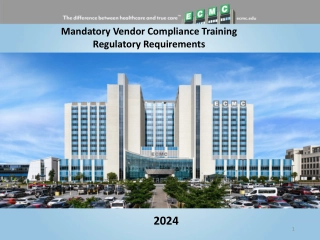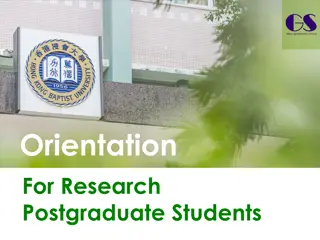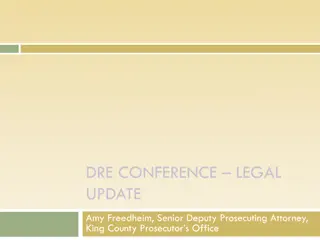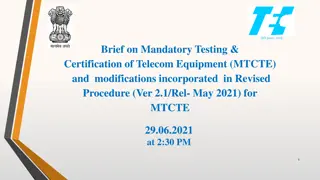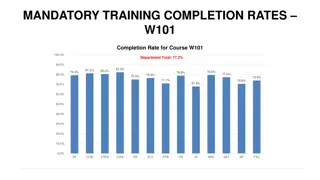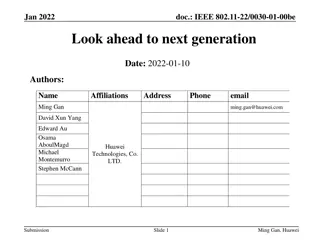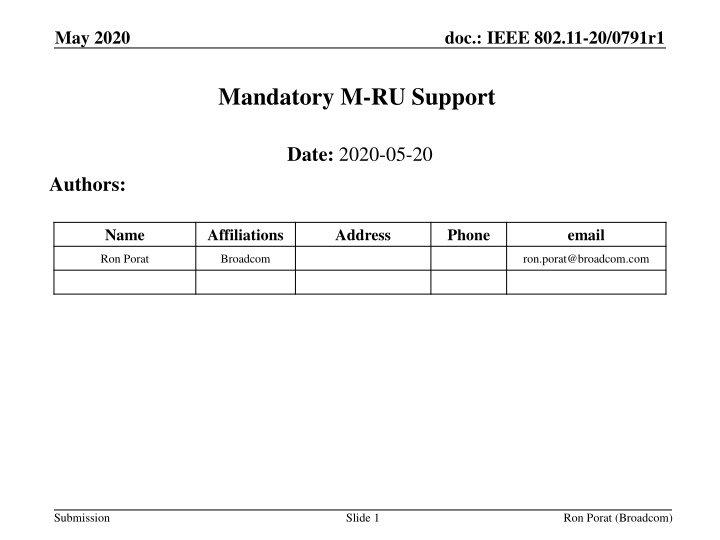
IEEE 802.11-20/0791r1 Proposal for Mandatory M-RU Support
Explore the proposal for making M-RU a key differentiating feature in the IEEE 802.11be standard relative to 11ax. The document discusses the advantages of different M-RU sizes and mandatory RU combinations for both OFDMA and non-OFDMA transmissions, aiming to enhance scheduling efficiency and flexibility in wireless communication systems.
Download Presentation

Please find below an Image/Link to download the presentation.
The content on the website is provided AS IS for your information and personal use only. It may not be sold, licensed, or shared on other websites without obtaining consent from the author. If you encounter any issues during the download, it is possible that the publisher has removed the file from their server.
You are allowed to download the files provided on this website for personal or commercial use, subject to the condition that they are used lawfully. All files are the property of their respective owners.
The content on the website is provided AS IS for your information and personal use only. It may not be sold, licensed, or shared on other websites without obtaining consent from the author.
E N D
Presentation Transcript
May 2020 doc.: IEEE 802.11-20/0791r1 Mandatory M-RU Support Date: 2020-05-20 Authors: Name Affiliations Address Phone email Ron Porat Broadcom ron.porat@broadcom.com Submission Slide 1 Ron Porat (Broadcom)
May 2020 doc.: IEEE 802.11-20/0791r1 Abstract Previously, each major amendment had a PHY feature clearly differentiating that amendment from the previous one e.g. 80MHz in 11ac and OFDMA in 11ax Propose to make M-RU a PHY differentiating feature of 11be relative to 11ax Submission Slide 2 Ron Porat (Broadcom)
May 2020 doc.: IEEE 802.11-20/0791r1 Discussion The current SFD defines large M-RU and small M-RU that provide better scheduling efficiency in OFDMA (e.g. small M-RU) and support single user transmissions around spectrum holes in 5GHz (for Radar) and 6GHz (under AFC rules). The proposals in the SFD provide good balance of implementation complexity and utility (limit to only the most useful cases) It makes sense that 11be STA and AP devices support those cases to build an ecosystem around them. However when it comes to OFDMA (DL and UL) we can allow the AP the freedom to choose its preferred RU since this feature is totally under the control of the AP. Hence the proposal differentiates between non-OFDMA and OFDMA transmissions Submission Slide 3 Ron Porat (Broadcom)
May 2020 doc.: IEEE 802.11-20/0791r1 Proposal Propose to make the following RU combinations mandatory in: Non-OFDMA transmissions: for AP and non-AP STA OFDMA transmissions: for non-AP STA Mandatory RU combinations: Small: {26+52, 106+26} Large: as shown in the table Conditioned on device supporting 80, 160, 240 and 320MHz transmissions. 80MHz 484+242 160MHz 996+(484+242), 996+484 240MHz 3x996, 2x996+484, 2x996 (any 2) 320MHz 4x996, 3x996+484, 3x996 (any 3) Submission Slide 4 Ron Porat (Broadcom)
May 2020 doc.: IEEE 802.11-20/0791r1 Straw Poll 1 Do you support the proposal on slide 4? Submission Slide 5 Ron Porat (Broadcom)

